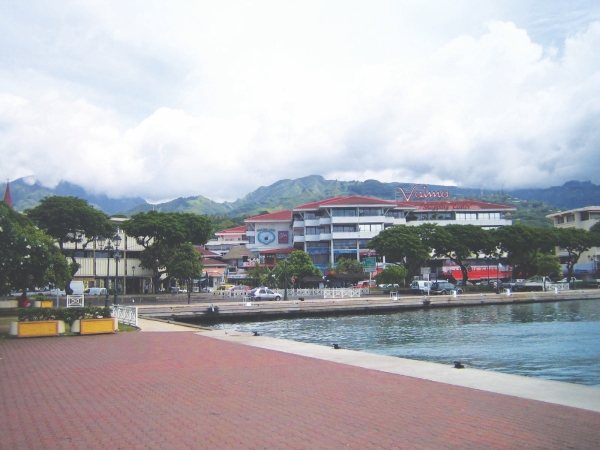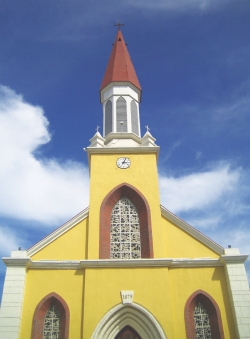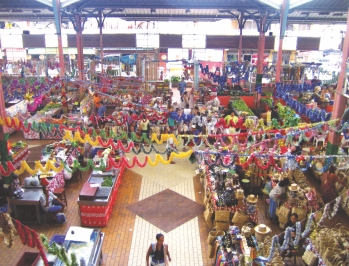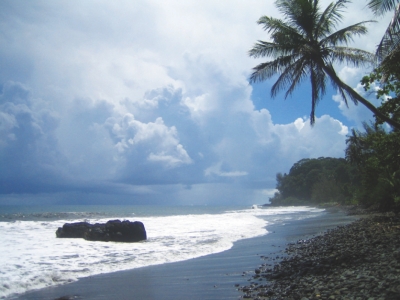| Home - Back Issues - The Team - Contact Us |
 |
| Volume 11 |Issue 41| October 19, 2012 | |
|
|
Travel
DO YOU SEE IT? Andrew Eagle
I wonder what happened when Obama was elected: was Finn empowered to reclaim her American-ness? I suspect she might've been. Do you see it? On the following morning, Finn left for the dock outside the Tahitian capital Papeete, to find the archaeology ship that would take her to the Marquesas Islands, one of the remotest areas of the Pacific. We shared a single day circumnavigating Tahiti Nui, the larger circle in the roughly figure-of-eight island of Tahiti. Finn herself was a series of circles. Her grey hair was short and rounded and there was neither too much melancholy nor seriousness in her dinner plate face. She looked as she was, practical-minded and ready for the road. I thought to tell her she was a jajabor, but I didn't get around to explaining the Bangla word for nomad. I'd never travelled with a Dutch-American grandmother before. It was early evening when we arrived back at the guest house. We walked up the laneway from the highway, past the breadfruit trees I admired for their bulbous fruits and the fleshy leaves. There wasn't much talk between us. We were tired. An hour or so earlier in Papeete we'd found le truck, the Tahitian bus service with half-open sides and impromptu seats, to take us on that last leg back, and I was glad we were no longer in the pick-up truck since there was a gendarme checkpoint and riding in the open back of pick-ups wasn't permitted. On le truck there could be no problem apart from the evening jam on the singular, circular highway we'd followed all the way back to the beginning. Papeete was laid back and peaceful. Sidled along an edge of a bay the Tahitian capital of about 130,000 people is bright with clothes, tropical flowers and colonial churches. Green is very much green there. The market, the Marché Papeete, is a few floors of clean, tin-roofed space of woven hats and Polynesian knickknacks. In Papeete the colonial atmosphere is not past tradition: Tahiti remains a French possession. French is the official language. But with Finn there'd been no time to dilly-dally. The town was an opportunity to find le truck.
After the pick-up stopped in Papeete's centre a few minutes earlier, I climbed down from the back and shook hands with the driver to thank him. Finn handed me a necklace the driver's wife had given us, one each, of red seedpods threaded along a string. Afternoon was already passing as we stood beside the road on the island's north coast, where the sea is rough and the sand black. We needed a ride into Papeete and there was less traffic on the north side. A pick-up stopped. At first we thought to refuse since the cabin was full, but, noticing Finn's age, one of the passengers offered her his cabin seat. A few minutes earlier we admired the Arohoho blowhole. Without the reef that lies in the south, surfers were taking advantage of the ocean swell. With each wave came a snort and a spray, like an elephant enjoying itself in a river, as the wave passed through the rounded rocky blowhole and burst upwards into the air. We were close enough to be wet. 'So how did you start travelling?' I got around to asking her.
A few minutes earlier we walked back from the waterfall to the coast road where the blowhole was, but it wasn't far and Finn was ready. She'd taken rest by the falls. There are three waterfalls at Faarumai. Finn had found a rock to sit upon at the first of them, Vaimahutu Falls, not far from the car park, while I raced off to find the other two. The three of them are similarly thin and tall. Down they come: direct and uncomplicated, over black tropical rocks into each pool. Finally I asked, 'have you ever been to Bangladesh?' She said she had and with breath held I asked what she thought. 'I liked it,' she said, and immediately spoke of the friendliness of Bangladeshis. An hour or so earlier we were setting off from the main road towards the falls on foot when a red car stopped. It was a couple of Canadians on their honeymoon. They drove us to the start of the trail. More than an hour earlier a car picked us up at the entry to the Paul Gauguin museum. Finn was telling me she'd been to Yemen and Egypt. 'Have you ever been to a dangerous country?' I asked her. 'There's no such thing as a dangerous country,' she said, 'only people can be dangerous. Do you see it?' 'And in places like Yemen and Egypt, is it a problem being American?' It's well known that American backpackers will deliberately sew Canadian maple leaf flags onto their backpacks when they travel. 'Sometimes I say that I'm Dutch,' she said, 'it's easier. Do you see it?' Yes I saw it, and I'd long enjoyed saying I was Australian because it'd meant once something quite different to American, at the start of the journey. The artist, Paul Gauguin, finally left France in 1895, never to return. He sailed to Tahiti to escape European civilisation and 'everything that is artificial and conventional.' And he took to his easel and canvas, but his paintings were for the most part unrecognised as significant until after his death. And for his support for the Tahitians against the French he was fined 500 francs and sentenced to 3 months jail. An hour earlier we stood in Paea, where there are two maraes or open air temple worth seeing: Arahurahu and Taata. Before the arrival of Christianity, the Maohi of Tahiti pursued their own religious rites and at each marae there was a stone platform with sitting places for the chiefs and an ahu or altar, as well as a tall post around which sacrifices were made. In absolute silence the tahu'a, the local priest, would offer prayers. In Tahiti perhaps the most popular of the gods was Oro, the god of war and wisdom. The first marae was not far from the guest house so that morning we started the tour on foot. If you stand at water's edge by the highway and look down, even in the shallows of bare centimetres of the perfectly clear water will be a multitude of tropical fish. Tahitian reef waters are a well-stocked aquarium. On the highway's inland side the hills rise up almost immediately: the cliffs and jagged peaks define the island's centre. It leaves a ring of humanity in Tahiti, along the inhabitable strip around the island's coast. It's a circular society. Before setting out we proposed where we could to take le truck, and otherwise to hitchhike. Being two might be a disadvantage in getting a ride from strangers but on the plus side they'd be perhaps more likely to stop. Who was going to leave a Dutch-American grandmother standing on the roadside? It was the night before that I met Finn, in the semi-outdoor kitchen area of the guest house. We were scrambling together a bit of food, each our own, when the talking started. She was on her way to the Marquesas, but with a day spare, she agreed to accompany me on a day-tour around Tahiti Nui. Do you see it?
|
||||||||||||||||
Copyright
(R) thedailystar.net 2012 |




